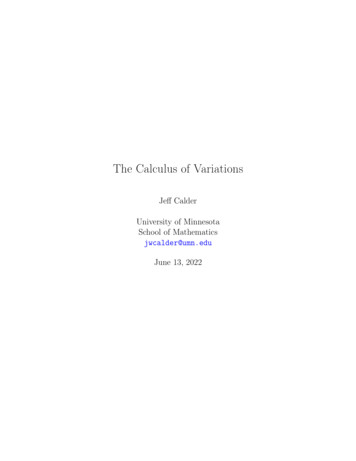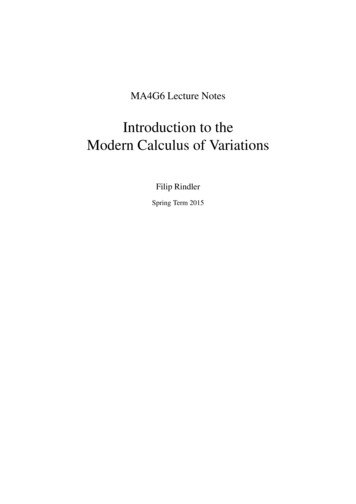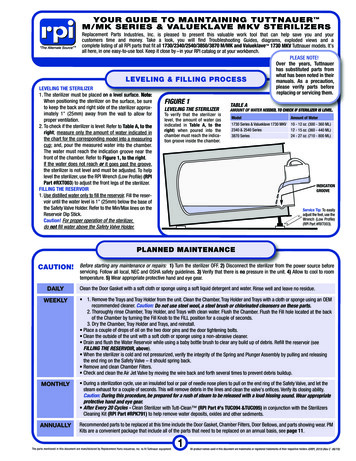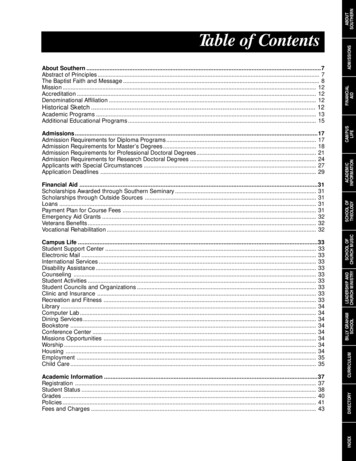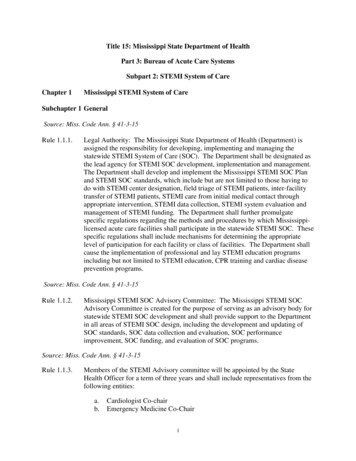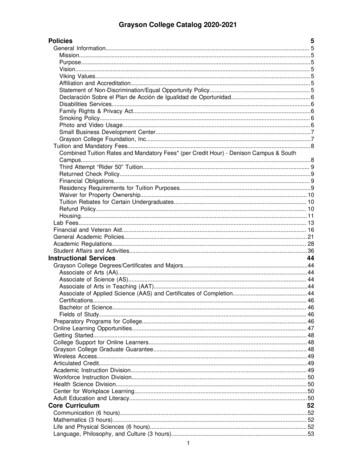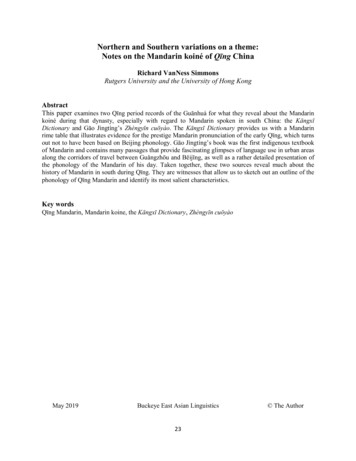
Transcription
Northern and Southern variations on a theme:Notes on the Mandarin koiné of Qīng ChinaRichard VanNess SimmonsRutgers University and the University of Hong KongAbstractThis paper examines two Qīng period records of the Guānhuà for what they reveal about the Mandarinkoiné during that dynasty, especially with regard to Mandarin spoken in south China: the KāngxīDictionary and Gāo Jìngtíng’s Zhèngyīn cuōyào. The Kāngxī Dictionary provides us with a Mandarinrime table that illustrates evidence for the prestige Mandarin pronunciation of the early Qīng, which turnsout not to have been based on Beijing phonology. Gāo Jìngtíng’s book was the first indigenous textbookof Mandarin and contains many passages that provide fascinating glimpses of language use in urban areasalong the corridors of travel between Guǎngzhōu and Běijīng, as well as a rather detailed presentation ofthe phonology of the Mandarin of his day. Taken together, these two sources reveal much about thehistory of Mandarin in south during Qīng. They are witnesses that allow us to sketch out an outline of thephonology of Qīng Mandarin and identify its most salient characteristics.Key wordsQīng Mandarin, Mandarin koine, the Kāngxī Dictionary, Zhèngyīn cuōyàoMay 2019Buckeye East Asian Linguistics23 The Author
1. IntroductionIt is generally assumed that the national capital is a priori the locus of the spoken standard inChina in traditional times. This leads to the conclusion that China’s historical koiné known asGuānhuà 官話 was thus based on the Běijīng 北京 dialect as soon as the capital moved toBěijīng in the early decades of the Míng dynasty in 1421. But the linguistic and geographicalbasis of the “standard Mandarin dialect” in Qīng times presents a far more complex picture. TheGuānhuà that served as the “standard language for officials” in the Míng and the Qīng had awide geographical base and took a much greater variety of forms than the single city of Běijīngcan account for. It had two major varieties, a northern type and a southern type, that coexisted formuch of the history of the two dynasties. The variety that carried the most weight in over thecenturies was actually not the northern type akin to Běijīng, but the southern type, which was afive-tone southern-type Mandarin. Various permutations of this standard lasted from the earlyMíng through the end of the Qīng and even into the Republican period.2. The two types of MandarinFrom the perspective of dialect evolution, Qīng period Mandarin was not a single language.Since well before the Míng, the Mandarin dialects already demonstrated great diversity. 1 Theoldest and deepest split within the Mandarin dialects is that between northern and southern types.Though similar in many ways, there are clear and significant phonological differences betweenthese two types. From a historical perspective, the southern type is older and more conservative,while the northern type is an innovative variety that made its first encroachment deep intoChinese territory only following the collapse of the Northern Sòng 宋 (960–1127) and the Jīn 金(1115–1234) takeover of north China. Prior to that, the southern type was dominant in the centralplains, including in Kāifēng 開封, the Northern Sòng capital, until its speakers fled south withthe dynasty. Later, the descendant of this southern type was widely spoken in the regions ofmodern Ānhuī 安徽 and Jiāngsū 江蘇, the territories from which Zhū Yuánzhāng 朱元璋 (1328–1398) marched forth to expel the Mongol Yuán 元 (1271–1368) dynasty and established theMíng dynasty. The language of the capital of Zhū Yuánzhāng’s new Míng dynasty, Nánjīng 南京, was a variety of this southern type, which thus can also be called the Jiāngnán 江南 (‘southof the Yangtze’) type. This Jiāngnán Mandarin carried forward the prestige of the southernMandarin that had been established in the Sòng and came to serve as the exemplar for theMandarin-based lingua franca spoken by officials in the Míng, or in other words, Guānhuà. 2The prestige of the language is demonstrated by the preference for Guānhuà pronunciationand usage, particularly that of southern Mandarin, among the educated literati and others ofelevated social status and mobility in their conversation and reading practices, as well as in theirinteractions across dialect and other linguistic boundaries. The discussion below provides anumber of examples that illustrate this preference and the various forms it takes. The wideThis summary overview of the history of Mandarin is based in part on Coblin (2000) and Simmons (2015).Coblin (2007) notes that “during most of the Míng/Qīng period the preferred way of pronouncing Guānhuà(hereafter GH) had originated in the Yangtze Watershed (Lǐ 1980; Lǔ 1985; Yang 1989; Coblin 1997). In addition tothis, there was also a less prestigious northern type of GH pronunciation. The Chinese of traditional times were wellaware of this difference. They referred to the southern type pronunciation as nányīn 南音 and to the northern asběiyīn 北音”. Also see Lǐ Xīnkuí 1997.1224
geographical distribution and deep historical roots of Míng period Guānhuà, dating back to itsnorthern Sòng origins, added to the prestige that Mandarin gained through association with theMíng dynasty’s founding emperor. This prestige and the accompanying influence held fast evenfollowing the move of the Míng capital to Běijīng in 1421 and through the end of the Qīngdynasty.3. The Southern Mandarin in the Imperial DictionaryIn the mid 17th century a non-Chinese ethnic group, the Manchus, swept in from the northeast topush out the Míng rulers and establish the Qīng dynasty. By this time, southern Mandarin-basedGuānhuà had become deeply and firmly entrenched as the prestigious lingua franca, or commonkoiné — the common supra-regional spoken language — of the native Chinese Hàn 漢 literati.So much so that the new non-Chinese rulers yielded to its prestige and essentially codified it inthe Imperial Dictionary that was compiled under the fourth Qīng emperor, Kāngxī 康熙 (r.1661–1722): the Kāngxī zìdiǎn 康熙字典 completed in 1716 under the direction of Zhāng Yùshū張玉書 (1642–1711). It is no surprise, then, that the French scholar DuHalde identified Jiāngnán(“Kiang nan”) Mandarin as “convenient for the government” when he wrote in 1735:The Mandarin-Language is properly that which was formerly spoken atcourt in the province of Kiang nan, and spread into the other Provinces amongthe polite People; and hence it is that this Language is better spoken in theProvinces adjoining to Kiang nan then in the others, but by slow degrees it wasintroduced in all Parts of the Empire, which is very convenient for thegovernment; (DuHalde 1741:389-390; emphasis added.)This language is reflected in the Kāngxī zìdiǎn in the first of two rime tables the Qīngcompilers included in the introductory material to the dictionary. 3 (The second rime table in thedictionary is a traditional Qièyùn 切韻 rime table.) It is unnecessary, and perhaps impossible, toidentify a specific dialect that underlies the Mandarin rime table in the dictionary. It is evenentirely possible that the table was not based on any single dialect. Nonetheless, it reflectsfeatures that are characteristic of the Jiāngnán prestige language and that were also taken to beindispensable elements of the commonly accepted colloquial standard. The principal southernMandarin features that can be discerned in the Kāngxī zìdiǎn rime table are illustrated in Table 1.The key features are as follows: 3The shift of Common Chinese voiced obstruent initials to voiceless aspirated initialso In a two register píng 平 tone.The loss of Common Chinese final consonants -p, -t, and -ko With rù 入 tone preserved as a category, having a weak final glottal stop -ʔ.A resulting system of five tones:o Upper (shàng 上, qīng 清, or yīn 陰) píng 平, lower (xià 下, zhuó 濁, or yáng 陽)píng 平, shǎng 上, qù 去, and rù 入.See Lǐ Xīnkuí 1980a (rpt. 1997) for a detailed introduction to both of the Kāngxī zìdiǎn rime tables.25
In Table 1, pre-Mandarin ancestral dialect forms (the starred syllables) are represented byCommon Dialectal Chinese (CDC); modern Mandarin is represented by Hànyǔ pīnyīn 汉语拼音. 4 The evolution of the forms from CDC to Mandarin is indicated with arrows. The Mandarindistinction between upper and lower píng tones is reflected in the distinction between first tone(with level tone mark, as in ā) and second tone (with rising tone mark, as in á) in pīnyīn. Thus,for example, tíng 庭 ‘hall, courtyard’, which is derived from a syllable with CDC voiced initial*d-, has evolved to contrast (in tone only) with tīng 聽 ‘listen’, which is derived from a syllablewith a voiceless aspirated initial *th-, the former being in lower píng tone and the latter being inupper píng tone. Note also that syllables with sonorant initials (n- in the examples) remain in theshǎng tone (third tone with inverted circumflex, as in ǎ), while those with CDC voiced initials inthe shǎng tone have merged with qù tone (fourth tone with falling tone mark, as in à). Thismeans, for example, that dì 弟 ‘younger brother’ is not “dǐ”. These are also distinctivecharacteristics of Mandarin dialects in general. A glottal stop [ʔ] has been added to the Mandarinrù tone syllables, indicated by italics in Table 1, which was commonly pronounced in traditionalsouthern Mandarin. 5Table 1. Representative Mandarin tones and initials in the Kāngxī zìdiǎn Mandarin rime table.Initial ní 泥Type *nSonorantToneSouthern Mandarindìng 定*dVoiced平píng寧níng庭 [*diang]上shǎng去qù入rù 𩕳𩕳nǐng甯nìng(溺)(*niak)訂 dìng定dìng(狄)(*diak)tòu 透*thVoicelessAspirated庭 ( 聽)tíng( tīng)挺tǐng聽tìng(剔)(*thiak)Northern Mandarinduān 端*tVoicelessní 泥*nSonorantdìng 定*dVoicedduān 端*tVoiceless提 [*diai]tòu 透*thVoicelessAspirated提 ( 梯)tí ( ǐ迡nì溺nìʔ弟 ��díʔ低dīThe status of the rù tone constitutes the primary phonological distinction between northernand southern types of Mandarin. Southern Mandarin had the rù tone and northern Mandarin didnot have it. Chinese scholars were well aware of this difference from very early on. In a lateMíng discussion of the regional characteristics of Guānhuà, Zhāng Wèi 張位 (1538–1605) in hisBased on Norman 2006, CDC is a rendering of the shared phonology of the Chinese dialects, excluding the Mǐn 閩dialects. It is thus representative of the common ancestral features of the non-Mǐn dialects.5The glottal stop ending is found on most rù syllables in modern Mandarin dialects that preserve the rù tone in theJiāng-Huái region and elsewhere. The Kāngxī zìdiǎn also clearly states that the “rù tone is short with an abruptending 入聲短促急收藏” and “makes use of a shortened syllable 借短言” where it is found. Lǐ Xīnkuí surmisedthat the rù tone ending was already lost in the language represented in the Kāngxī zìdiǎn, but that the rù tonecategory still maintained its own distinctive characteristics (“还是有它自己的特点”), see Lǐ 1980a (rpt. 1997): 286.Our judgment is that the exact phonetic realization of the rù tone varied depending on the speaker.426
Wèn qí jí 問奇集 [Collected Notes on the Unusual] (preface 1590) addresses the issue in asection titled “Gèdì xīangyīn 各地鄉音” [“Regional Pronunciations of Various ��語,更未易通也。(juàn B, p. 41a.)‘In general, the rù tone is pronounced as a píng tone north of the Yangtze; andthere are also many pronunciations that have no corresponding Chinese characterwhich cannot be fully listed here. South of the Yangtze the dental soundsfrequently suffer from muddled pronunciation; but this is merely a regional accentin Guānhuà. If the various local dialects are used, it is even more difficult tocommunicate.’We can see in the examples of Table 1 that the Kāngxī zìdiǎn Mandarin rime table maintainsa distinct rù tone whose constituent syllables have shifted to be parallel with, or close inpronunciation to, open syllables with the same main vowel, but not merged with them. 6 At thesame time, the Kāngxī zìdiǎn also clearly depicts the Mandarin shift of Common DialectalChinese voiced obstruent initials in píng tone syllables to voiceless aspirated initials, alsoillustrated in Table 1. Taken together, this pair of phonological features confirms that theImperial Dictionary rime table represents a type of Mandarin, and that southern Mandarin is thetype the compilers’ preferred.The early Qīng preference for the southern Guānhuà koiné is also reflected in revisions thatthe Manchus made in transcriptions of Chinese following their conquest of China. CommonDialectal Chinese velar initials before high-front vowels were already palatalized when theManchus first began learning Chinese from speakers in northeast China. Reflecting this, theManchus transcribed a palatal pronunciation in Manchu renderings of Chinese syllables in theirearly translations of Chinese, such as the translation of the Romance of the Three Kingdoms (Sānguó yǎnyì 三國演義), Ilan gurun. But after moving into Běijīng, their transcriptions of the samesyllables reverted to a southern Mandarin velar pronunciation, as illustrated in Table 2 in whichthe relevant initial consonants are indicated in bold. 7The preservation of the velar pronunciation was a characteristic feature of the Guānhuà koinéwell into the 19th century. The fact that the Manchus adopted this feature in their Chinesetranscriptions after their conquest of the Míng is strong corroboration of the prestige of thesouthern Mandarin that is reflected in the Kāngxī Imperial Dictionary, the authoritative positionof which the Qīng court went to severe lengths to maintain (Kaske 2008: 43). China’s ruling eliteclearly continued to prefer the Jiāngnán Guānhuà that had dominated in the Míng, and theManchus were persuaded that it was the preferred prestige form. 8 Hence, the closest thing thereis to a recorded “standard” Guānhuà promulgated widely in the Qīng is a five-tone southern typeMandarin.This is in contrast to what is seen in the 14th century Zhōngyuán yīnyùn, which has merged the rù syllables into theother tones and represents a Mandarin clearly of the northern type.7Data in Table 2 is from an unpublished presentation by Jerry Norman from 1989, courtesy of William G. Boltz.8Coblin 2003 provides an extensive discussion of the influence of southern Guānhuà on the Mandarin learned by6the Manchus as reflected in the Qīngwén qǐméng 清文啟蒙, a Manchu textbook for Chinese readers dated 1761.Elements of the issue are also discussed in Yamazaki Masato 1990.27
Table 2. Shift of Manchu transcriptions from prepalatal to e’‘gold’‘in āxiàoxǔjiǔjīnxié三國演義 Ilan jinjiyai康熙 Kāngxī and later(r. oiGioGinGiyai4. The Mandarin Recorded in Gāo Jìngtíng’s Zhèngyīn cuōyàoOne hundred years after the Kāngxī zìdiǎn was completed, the southern type of Mandarincontinued to prevail as the preferred colloquial variety, though the northern type was also heardin both north and south China. Coexisting with northern Mandarin, the Jiāngnán type of Guānhuàhad widespread currency as the relatively dominant lingua franca for use throughout the empire.A contemporary description of the situation is provided by Gāo Jìngtíng 高靜亭 (fl. 19th c.), thecompiler of the first indigenous textbook of Guānhuà, the Zhèngyīn cuōyào 正音撮要 [Synopsisof standard pronunciation]. 9 Gāo Jìngtíng was from Xīqiáo township in what is modern Nánhǎicity in Guǎngdōng (廣東省南海市西樵鎮). He tells us in the preface to his text that he learnedGuānhuà after traveling with his father to Northern Zhílì 北直隸 (in the area of modern Héběi 河北) when he was 13 years old. The pronunciation of Northern Zhílì in 1752 had been designatedas the standard for the pronunciation of court rituals administered by the Hónglúsì 鴻臚寺, theCourt of Imperial Ceremonies (Hirata 2000). While living there in his teens, Gāo developed afairly confident proficiency in Guānhuà and decided to compile a reference for those of his homeprovince and others who wished to learn that language.Gāo described the prevalence and usefulness of the Mandarin koiné in the preface to histextbook (dated 1810) as follows:論官話能通行 “Guānhuà Affords Easy ��話也有,南話也有,Identified as “the earliest standard pronunciation text of the Qing dynasty 目前所见最早的清代‘正音课本’” byWáng Wèimín 2000.928
差得遠。 (juàn 卷 1, p. 3a.)‘What the Kāngxī zìdiǎn refers to as local colloquial, can hardly be simplynorthern and southern differences. All adjoining prefectures are naturally different,and it can generally be said that all of the provinces and prefectures in the empireeach has its own local colloquial and regional patois. The people of one county donot understand the speech of another county; and such is the case in all theprovinces, not simply in Fújiàn and Guǎngdōng. I have traveled in Jiāngnán,Zhèjiāng, Hénán, Húběi and Húnán. The local language and regional patios isdifferent in each place. Even among neighboring counties and prefectures they donot understand each other. Only when traveling on the canals and at thewharves, the people of those businesses engaging in commerce all know howto speak Guānhuà. But they speak the local patois to the people of theirneighborhood; and we do not understand. It is even stranger in the capital. Thereare great numbers of people strolling in the avenues, in groups of 3 or 5, speakingtheir local colloquial in a great cacophony. One has no idea what they are saying.But when they enter the shops to make purchases, they are fully conversant inGuānhuà, of which northern and southern vernaculars can both be heard, allspoken quite clearly. When asked where they are from, we learn they are fromtowns and villages in all the provinces. Not one of those who wish to journeyforth in search of fame and fortune does not learn Guānhuà. If one does notlearn it, it is not possible to get around. But in all the provinces, most have a fairlystandard accent. And when they speak Guānhuà, one discerns no difficulty, all areeasy to understand. Only people from Fújiàn and Guǎngdōng have poor accents;and in speaking of things and addressing others, they are off by a long shot.’(Emphasis added.)In its character and widespread regional utility, the Guānhuà that Gāo describes hererepresents a classic koiné situation. This koiné, a term which can be nicely rendered in Chineseas tōngyǔ 通語, was clearly a socially accepted common supra-regional vernacular languagestandard that formed through contact between two or more mutually intelligible varieties ordialects of Mandarin. 10 As Gāo notes, its speakers did not abandon their own native vernacularsor dialects, but rather used the Mandarin koiné for communication across China’s vast territorieswhile continuing to use their own local languages at home and with their provincial compatriots.Though he indicates in the above passage that this koiné encompasses both “northern andsouthern vernaculars” (běiyǔ 北語 and nányǔ 南語), we find that the Mandarin pronunciationrepresented in his Zhèngyīn cuōyào is firmly of the southern type. In the fourth juàn 卷 ofZhèngyīn cuōyào, Gāo presents a syllabary of homophones for the Guānhuà of his text, withpronunciations glossed using the traditional fǎnqiè 反 切 method — a set of two spellercharacters, the first of which shares an initial (alliterates) with the glossed syllable, and theThe Chinese word tōngyǔ 通語 ‘lingua franca, koiné’ dates back at least as early as Yáng Xióng’s 揚雄 (53 BCE–18 CE) Fāngyán 方言 [Regional language], in which it is frequently used.1029
second of which shares the final and tone (and thus rhymes) with the glossed syllable. Ananalysis of Gāo’s pronunciation glosses in this juàn reveals that the Guānhuà presented in histextbook has the typical five-tones of the Jiāngnán koiné:1. Yīnpíng syllables are always glossed with second-syllable speller characters that have ayīnpíng tone. For example, dōng 東 is glossed with dēng gōng (登公切), as opposed tothe dé hóng (德紅切) of the traditional Qièyùn system in the Guǎngyùn 廣韻; tāng 湯 isglossed with tái shāng (台商切).2. Yángpíng syllables are always glossed with second-syllable speller characters that have ayángpíng tone. For example, pín 貧 is glossed with pí mín (皮民切), as opposed to thefú jīn (符巾) of the Guǎngyùn; lán 藍 is glossed with lí nán (梨南切).3. Upper shǎng syllables (that correspond to the traditional yīnshǎng category) are alwaysglossed with second-syllable speller characters that have a shǎng tone: děng 等 is glosseddīng gěng (丁梗切); zhǐ 紙 is zhēn yǐ (真以切) with a note that it is homophonous withzhǐ 止. As is typical of Mandarin, this tone includes syllables with sonorant initials: měi每 is glossed mí wěi (迷委切) with a note that it is homophonous with měi 美.4. Qù tone reflects a merger of traditional Qièyùn upper and lower (yīn and yáng) qù tonestogether with lower (yáng) shǎng, all of which categories are distinct in CommonDialectal Chinese. Hence jiù wò (臼臥切) glosses the pronunciation of yángshǎng zuò坐 and yīnqù zuò 做, while jì jiù (記就切) glosses yángqù jiù 舊, yángshǎng jiù 舅, andyīnqù jiù 救. We also find a note that says yángqù dòng 洞 is homophonous withyángshǎng dòng 動 (“洞入動字”).5. Rù tone syllables form a discrete category in Gāo’s system. They are all provided withfǎnqiè spellings that are separate from the other tones and are grouped together with nodistinction between Common Dialectal Chinese final consonants *-p, *-t, and *-k. Thus lì立, lì 力, and lì 笠 (respectively having CDC endings *-p, *-t, and *-k) are all glossedwith lái dí (來敵切); and jí 及 and jí 吉 (ending in CDC *-p and *-t respectively) arejì yī (計一切). Moreover, there is no upper and lower register distinction in the rù toneof Zhèngyīn cuōyào. Thus for example, jī xū (基戌切) serves as the pronunciation glossfor both Common Dialectal Chinese upper register syllables jú 橘, jú 鞠 and jú 菊, aswell as CDC lower register syllables jú 局 and jú 跼.Gāo’s Mandarin phonology also evidences a preservation of the so-called jiānyīn 尖音pronunciation: Common Dialectal Chinese dental sibilants are preserved before high-frontvowels and are not palatalized. This can be seen where cǐ jié (此節切) is used to gloss thepronunciation of qiè 切 and qiè 妾, which both would thus be pronounced “cièʔ” ([ʦʻieʔrù] not[ʨʻieʔ rù]) in Gāo’s Guānhuà. Also note jìng dài (靜代切) glosses yīnqù zài 再 and yángshǎngzài 在, which reveals that Gāo’s Guānhuà would pronounce jìng 靜 as “zìng” ([ʦiŋqù] not [ʨiŋqù]).This preservation of jīanyīn dental sibilants before high front vowels is a further hallmark featureof the southern Mandarin based Míng-Qīng Guānhuà koiné. Finally, it is of note that Gāo’sGuānhuà fǎnqiè spellings maintain a clear distinction between initials n- and l-, and betweenvelar and dental nasal final consonants -n and -ng. But CDC final *-m is merged with final *-n.For example, nán 南 (CDC *nom2) and nán 難 (CDC *nan2) are both glossed níng lán (寧蘭切).30
Because it contains a rù tone, the importance of which was described above, the quintupletone system represented in the phonology of the Zhèngyīn cuōyào and that is found in most otherforms of southern Mandarin carried powerful normative influence. This normative influence isevident, for example, in a 19th century description of a Jiāngnán Mandarin dialect that had seventones. The eighty scroll Yùnshǐ 韻史 [History of rimes] compiled by the Qīng scholar Hé Xuān何萱 (1774–1841) presents the phonology of Hé’s hometown dialect near modern Tàixīng 泰興.The modern dialects of the Tàixīng-Rúgāo 如皋 region in Jiāngsū have a seven tone phonology,with upper and lower registers in both the qù and the rù tones. But though Hé Xuān is able tometiculously and accurately reflect the voiceless aspirated obstruents that are characteristic ofsyllables in yángqù and yángrù tone categories in all of the Tōng-Tài 通泰 area dialects (but notseen in other Mandarin varieties), his phonological glosses merge upper qù with lower qù, andupper rù with lower rù. The result is that his phonological system clearly distinguishes only thefive tones typical of southern Mandarin. This led the modern scholar Lǔ Guóyáo 魯國堯 toremark that Hé Xuān “did not dare completely turn his back on established tradition” 不敢盡背舊傳統 (1988: 188), while Gù Qián 顧黔 subsequently noted that Hé “clearly carried forth thefive-tone interpretation of the Yuán and Míng periods” 顯然是承元明以來五聲之說 (1996: 170,2001: 6). 115. ConclusionTo sum up our characterization of the Qīng Mandarin standard, we have identified the followingsalient features regarding China’s prestige koiné Guānhuà in the early 19th century based on theImperial Dictionary and Gāo Jìngtíng’s Zhèngyīn cuōyào:i.ii.iii.iv.v.vi.It had five-tones: upper píng, lower píng, shǎng, qù, and rù, as discerned even in theMandarin rime table of the Kāngxī Dictionary.The lower shǎng of CDC is merged with qù (excluding syllables with sonorant initials)and there is no upper-lower register distinction in the qù and rù tones, as illustrated inTable 3.CDC voiced initials are voiceless aspirated in the lower píng and voiceless unaspirated inthe shǎng, qù, and rù tones.CDC velars before high front vowels were not palatalized and remained velar inpronunciation (as illustrated by the Manchu transcriptions in Table 2).CDC dental sibilants are preserved before high front vowels, as the so-called jīanyīn, andare not palatalized.CDC final consonants *-p, *-t, and *-k are merged under single rù tone spellings; andCDC final *-m is merged with final *-n.Table 3: The five tones of Qīng Guānhuà.yīn 陰yáng 陽11píng 平12shǎng 上3qù 去rù 入45Simmons 2014 provides a detailed analysis of the phonology and tones in Hé Xuān’s Yùnshǐ.31
This Mandarin koiné and these characteristics were well established and already at least 500years old by the start of the 19th century, when considered in light of their Sòng origins notedabove. Clearly, they had not been dislodged by the move of the capital in the Míng; nor had theybeen superseded later, after close to two centuries of Manchu rule in the Qīng.ReferencesCoblin, W. South. (1997) Notes on the Sound System of Late Ming Guanhua. Monumenta Serica45, 261-307.Coblin, W. South. (2000) A Brief History of Mandarin. Journal of the American Oriental Society120/4, 537-552.Coblin, W. South. (2003) A Sample of eighteenth century spoken Mandarin from North China.Cahiers de linguistique - Asie orientale 32.2, 195-244.Coblin, W. South. (2007) Modern Chinese phonology: from Guānhuà to Mandarin, Collectiondes Cahiers de linguistique - Asie Oriental 11.DuHalde, P. (1741) The General History of China (translated from the original French). Vol. 2.London: J. Watts.Gāo Jìngtíng (高靜亭). (n.d.) Zhèng yīn cuōyào (正音撮要) [Synopsis of standard pronunciation],preface 1810, edition published 1920 archived at Hathi Trust Digital Libraryhttp://www.hathitrust.org, scan of original from University of Michigan, 4 v. (double leaves)in 1.16 cm., accessed May 5, 2015 at http://hdl.handle.net/2027/mdp.39015057198403Gù Qián (顧黔). (2001) Tōng-Tài fāngyán yīnyùn yánjiù (通泰方言音韻研究) [The Phonology ofthe Tōng-Tài Dialects]. Nánjīng: Nanjing University Press (南京大學出版社).Lǐ Xīnkuí (李新魁). (1980) Lùn jìndài Hànyǔ gòngtóngyǔ de biāozhǔnyīn (论近代汉语共同语的标准音) [On the standard pronunciation of the early Mandarin]. Yǔwén yánjiū (语文研究). 4452.Lǐ Xīnkuí (李新魁). (1980a) Kāngxī zìdiǎn de liǎngzhǒng yùntú (《康熙字典》的两种韵图) [Thetwo rime tables in the Kāngxī zìdiǎn]. Císhū yánjiū 1, 174-182.; (1997) reprinted in Lǐ Xīnkuíyīnyùnxué lùnwénjí ( 李 新 魁 音 韵 学 论 文 集 ) [Lǐ Xīnkuí studies in phonology], 280-289.Shàntóu (汕头): Shàntóu dàxué chūbǎnshè (汕头大学出版社).Lǐ Xīnkuí (李新魁). (1997) Jìndài Hànyǔ nán-běi yīn zhī dà jiè (近代汉语南北音之大界) [Themajor boundary between northern and southern pronunciations in early Mandarin]. In LǐXīnkuí yīnyùnxué lùnwénjí (李新魁音韵学论文集 )[Lǐ Xīnkuí studies in phonology], 228-266.Shàntóu (汕头): Shàntóu dàxué chūbǎnshè (汕头大学出版社).Lǔ Guóyáo (鲁国尧) (1985) Míng dài Guānhuà jí qí jīchǔ fāngyán wèntí–dú Lì Mǎdòu Zhōngguózhájì ��窦中国札记》) [Míng period Guānhuà and thequestion of its underlying dialect]. Nánjīng dàxué xuébào (南京大学学报) 4, 47-52; (1994)reprinted in the Lǔ Guóyáo zìxuǎnjí ( 鲁国尧自选集 ) [Selected writing of Lǔ Guóyáo].Chángshā (长沙): Húnán jiàoyù chūbǎnshè (湖南教育出版社).Lǔ Guóyáo (魯國堯). (1988) Tàizhōu fāngyīn shǐ yǔ Tōng-Tài fāngyán shǐ yánjiù (泰州方音史與通泰方言史研究) [Investigation of the history of the Tōng-Tài dialects and the history of32
Tàizhōu pronunciation]. Ajia-Afurikago no Keisū Kenkyū (アジ ア・ アフリカ語の計数研究)[Computational Analyses of Asian Languages] 30, 149-219.Norman, Jerry. (2006) Common Dialectal Chinese. In David Prager Branner (ed.), The ChineseRime-Tables: Linguistic Philosophy and Historical-Comparative Phonology. 233-254.Amsterdam: John Benjamins.; Chinese translation: Hànyǔ fāngyán tōngyīn (汉语方言通音) tr.Richard VanNess Simmons and Zhāng Yànhóng (张艳红). (2011) Fangyan (方言) 2, 97-116.Simmons, Richard VanNess. (2014) A Comparative Look at Common Southern Jiāng-Huái andthe Southern Mandarin Influences in Hé Xuān’s Yùnshǐ. In Richard VanNess Simmons andNewell Ann Van Auken (eds.), Studies in Chinese and Sino-Tibetan Linguistics: Dialect,Phonology, Transcription and Text ��). Co-edited withLanguage and Linguistics Monograph Series 53. Taipei: Institute of Linguistics, AcademiaSinica (中央研究院語言學研究所), 133-153.Simmons, Richard VanNess. (2015) Varieties of Mandarin. In Rint Sybesma, et al. (eds.), TheEncyclopedia of Chinese Language and Linguistics, Leiden: Brill Online. Print oi.org/10.1163/22107363 ecll COM 00000238Wáng Wèimín (王为民). (200
Notes on the Mandarin koiné of . Qīng. China. Richard VanNess Simmons . Rutgers University . and the University of Hong Kong. Abstract . This paper examines . two Qīng period records of the Guānhuà for what they reveal about the Mandarin koiné during that dynasty, especially with regard to Mandarin spoken in south China: the Kāngxī .


